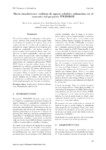Hacia simulaciones realistas de agarre robótico submarino en el contexto del proyecto TWINBOT

Use este enlace para citar
http://hdl.handle.net/2183/28288
A non ser que se indique outra cousa, a licenza do ítem descríbese como Atribución-NoComercial-CompartirIgual 4.0 Internacional (CC BY-NC-SA 4.0)
Coleccións
Metadatos
Mostrar o rexistro completo do ítemTítulo
Hacia simulaciones realistas de agarre robótico submarino en el contexto del proyecto TWINBOTTítulo(s) alternativo(s)
Towards Realistic Simulations of Underwater Robotic Graspings in the Context of the TWINBOT ProjectData
2021Cita bibliográfica
Ávila, M., Solis, A., Marín, R., Sanz, P.J., Martí, J.V. Hacia simulaciones realistas de agarre robótico submarino en el contexto del proyecto TWINBOT. En XLII Jornadas de Automática: libro de actas. Castelló, 1-3 de septiembre de 2021 (pp. 66-74). DOI capítulo: https://doi.org/10.17979/spudc.9788497498043.066 DOI libro: https://doi.org/10.17979/spudc.9788497498043
Resumo
[Resumen] El uso de tecnologías de videojuegos en las aplicaciones robóticas está siendo de gran ayuda tanto en el diseño de interfaces de usuario como en la implementación de servidores de simulación, que permitan un mayor realismo en las imágenes generadas por computador. Así mismo, cuando se
procura realizar una simulación donde existe contacto de un brazo manipulador, como por ejemplo en tareas de peg-in-hole, estas tecnologías no
están todavía suficientemente avanzadas. En este artículo describimos el estado actual de uno de los experimentos de simulación del proyecto TWINBOT,
donde se procura realizar tareas de manipulación con tuberías, incluyendo recuperación, transporte e inserción. El sistema utiliza la nueva versión de la física de Unity, a través del objeto Articulation Body, el cual da un mayor grado de precisión en el cálculo de fuerzas tras una interacción robótica con un objeto. El escenario de la simulación es submarino, pudiendo apreciar el nivel actual alcanzado con este tipo de sistemas. [Abstract] The use of video game technologies in robotic applications is being of great help both in the design of user interfaces and in the implementation of simulation servers, which allow greater realism in computergenerated images. Likewise, when trying to perform a simulation where there is contact of a manipulator arm, such as in pegin-hole tasks, these technologies are not yet sufficiently advanced. In this article we describe the current state of one of the simulation experiments of the TWINBOT project, which attempts to carry out handling tasks with pipes, including recovery, transport and insertion. The system uses the new version of Unity physics, through the Articulation Body object, which gives a greater degree of precision in the calculation of forces after a robotic interaction with an object. The simulation scenario is underwater, being able to appreciate the current level reached with this type of system.
Palabras chave
Simulaciones
Robótica Submarina
Manipulación
Interacción
Simulations
Marine robotics
Manipulation
Interaction
Robótica Submarina
Manipulación
Interacción
Simulations
Marine robotics
Manipulation
Interaction
Versión do editor
Dereitos
Atribución-NoComercial-CompartirIgual 4.0 Internacional (CC BY-NC-SA 4.0)
ISBN
978-84-9749-804-3






